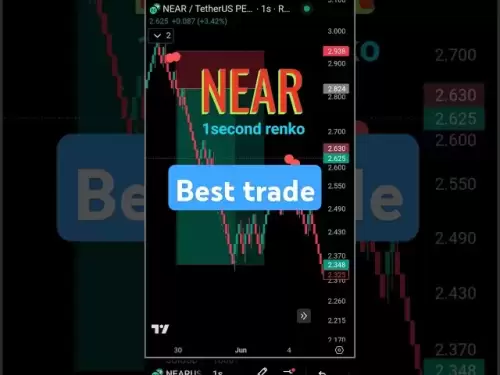-
 Bitcoin
Bitcoin $105,288.6945
-2.61% -
 Ethereum
Ethereum $2,546.9059
-7.84% -
 Tether USDt
Tether USDt $1.0004
0.05% -
 XRP
XRP $2.1438
-4.68% -
 BNB
BNB $653.2251
-1.80% -
 Solana
Solana $146.3449
-8.07% -
 USDC
USDC $0.9997
0.01% -
 Dogecoin
Dogecoin $0.1778
-5.94% -
 TRON
TRON $0.2688
-2.27% -
 Cardano
Cardano $0.6373
-7.04% -
 Hyperliquid
Hyperliquid $41.2776
-4.37% -
 Sui
Sui $3.0223
-9.71% -
 Chainlink
Chainlink $13.3280
-7.77% -
 Bitcoin Cash
Bitcoin Cash $430.6921
-2.12% -
 UNUS SED LEO
UNUS SED LEO $9.0426
1.98% -
 Avalanche
Avalanche $19.2275
-8.92% -
 Stellar
Stellar $0.2600
-5.55% -
 Toncoin
Toncoin $2.9984
-6.13% -
 Shiba Inu
Shiba Inu $0.0...01195
-5.71% -
 Hedera
Hedera $0.1566
-7.37% -
 Litecoin
Litecoin $84.6896
-5.28% -
 Polkadot
Polkadot $3.8188
-6.28% -
 Ethena USDe
Ethena USDe $1.0004
0.00% -
 Monero
Monero $311.9801
-3.66% -
 Dai
Dai $0.9998
0.00% -
 Bitget Token
Bitget Token $4.5149
-4.09% -
 Uniswap
Uniswap $7.4602
-6.13% -
 Pepe
Pepe $0.0...01088
-11.16% -
 Aave
Aave $280.9076
-8.02% -
 Pi
Pi $0.5699
-8.88%
Is the rapid rebound after the MACD dead cross a trap? How to judge whether it is a reversal or a pullback?
After a MACD dead cross, a rapid rebound can be misleading; traders should analyze volume, price action, and other indicators to discern true reversals from pullbacks.
Jun 11, 2025 at 11:50 pm
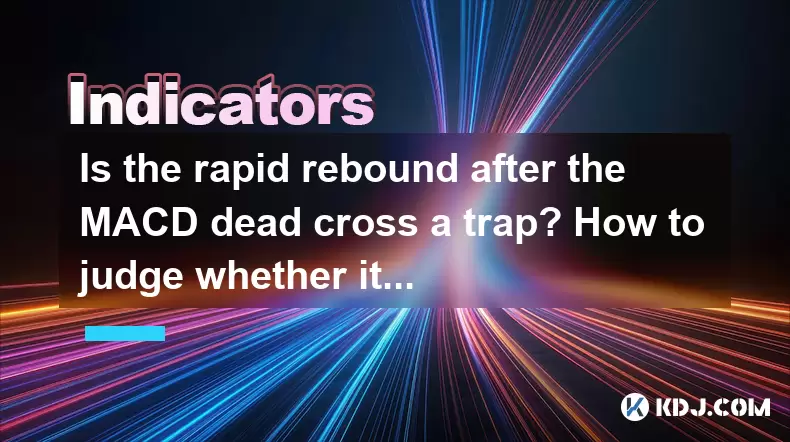
The MACD (Moving Average Convergence Divergence) indicator is a popular tool used by traders to identify potential trend reversals and momentum changes in the cryptocurrency market. A dead cross occurs when the MACD line crosses below the signal line, often signaling a bearish trend. However, a rapid rebound following such a cross can leave traders wondering if it's a trap or a genuine reversal. This article aims to delve into the nuances of these signals and provide guidance on how to discern between a true reversal and a temporary pullback.
Understanding the MACD Dead Cross
The MACD indicator consists of two lines: the MACD line and the signal line. A dead cross is identified when the MACD line crosses below the signal line. This event is typically interpreted as a bearish signal, suggesting that the downward momentum may increase. For example, if Bitcoin's price has been trending upward and the MACD line crosses below the signal line, it could indicate that the bullish trend is losing steam and a bearish reversal might be imminent.
The Phenomenon of Rapid Rebounds
A rapid rebound after a MACD dead cross can be confusing. It occurs when the price quickly recovers after the bearish signal, often leading to a short-term upward movement. This can be misleading because it may appear as though the bearish trend has been invalidated, tempting traders to enter long positions prematurely. For instance, if Ethereum experiences a dead cross and then rebounds sharply within a few hours, it might seem like a buying opportunity, but it could also be a trap designed to lure in bullish traders before the price continues to decline.
Factors to Consider in Judging Reversals vs. Pullbacks
To determine whether a rapid rebound is a genuine reversal or just a pullback, traders should consider several factors:
Volume Analysis: A true reversal is often accompanied by a significant increase in trading volume. If the rebound occurs with low volume, it might be a pullback rather than a reversal. For example, if the volume during Bitcoin's rebound is significantly lower than during the preceding downtrend, it could indicate a lack of conviction in the upward move.
Price Action and Support/Resistance Levels: Observing how the price interacts with key support and resistance levels can provide clues. A rebound that fails to break through a major resistance level might be a pullback. For instance, if Ethereum rebounds but fails to break a resistance level at $2,000, it might suggest that the upward move is temporary.
Other Technical Indicators: Combining the MACD with other indicators like the RSI (Relative Strength Index) or Bollinger Bands can offer a more comprehensive view. If the RSI remains in oversold territory despite the rebound, it might indicate that the upward move is a pullback rather than a reversal.
Market Sentiment and News: External factors such as market sentiment and news can influence price movements. A rebound that coincides with positive news might be more likely to be a genuine reversal. For example, if a favorable regulatory announcement is made about cryptocurrencies, a rebound following a dead cross might be more credible.
Case Studies and Real-World Examples
Examining real-world examples can help illustrate these concepts. Consider a scenario where Bitcoin experiences a MACD dead cross, followed by a rapid rebound. If the rebound is accompanied by high trading volume and breaks through a significant resistance level, it might suggest a true reversal. Conversely, if the rebound occurs with low volume and fails to break key resistance levels, it could be a trap.
Another example could be Litecoin experiencing a dead cross, followed by a rebound. If the rebound is short-lived and the price quickly returns to its downward trend, it would likely be a pullback rather than a reversal. Analyzing multiple instances can help traders develop a better understanding of these patterns.
Strategies for Trading Post-Dead Cross Rebounds
Developing a strategy to navigate post-dead cross rebounds involves a combination of technical analysis and risk management. Here are some steps traders can take:
Wait for Confirmation: Instead of jumping into a trade immediately after a rebound, wait for additional confirmation signals. This could include a subsequent MACD cross back above the signal line or a break above a resistance level.
Set Clear Entry and Exit Points: Define specific entry and exit points based on your analysis. For example, if you believe the rebound is a true reversal, enter a long position once the price breaks above a resistance level and set a stop-loss below a support level.
Use Stop-Loss Orders: Always use stop-loss orders to limit potential losses. If the rebound turns out to be a trap, a stop-loss can help mitigate the impact of a sudden price drop.
Monitor Multiple Timeframes: Analyzing the same asset across different timeframes can provide a more holistic view. A rebound that appears significant on a shorter timeframe might be less convincing when viewed on a longer timeframe.
Frequently Asked Questions
Q: Can the MACD dead cross be a reliable indicator on its own?
A: While the MACD dead cross can provide valuable insights into potential bearish trends, it is generally more effective when used in conjunction with other technical indicators and market analysis. Relying solely on the MACD dead cross might lead to false signals, especially in volatile markets like cryptocurrencies.
Q: How can I differentiate between a short-term and long-term reversal following a dead cross?
A: To differentiate between short-term and long-term reversals, consider the duration and strength of the rebound. A short-term reversal might be characterized by a quick but unsustainable upward move, while a long-term reversal would typically show sustained upward momentum over a longer period. Analyzing multiple timeframes and using additional indicators like moving averages can help distinguish between these scenarios.
Q: Is it advisable to trade against the trend immediately after a MACD dead cross?
A: Trading against the trend immediately after a MACD dead cross can be risky. It's often better to wait for confirmation of a reversal, such as a subsequent bullish MACD cross or a break above a key resistance level. Trading against the trend without confirmation can lead to significant losses if the bearish trend continues.
Q: How important is volume in confirming a reversal after a dead cross?
A: Volume is crucial in confirming a reversal after a dead cross. A genuine reversal is typically accompanied by a significant increase in trading volume, indicating strong market participation. If the rebound occurs with low volume, it might suggest a lack of conviction and could be a pullback rather than a reversal.
Disclaimer:info@kdj.com
The information provided is not trading advice. kdj.com does not assume any responsibility for any investments made based on the information provided in this article. Cryptocurrencies are highly volatile and it is highly recommended that you invest with caution after thorough research!
If you believe that the content used on this website infringes your copyright, please contact us immediately (info@kdj.com) and we will delete it promptly.
- Bitwise CEO Predicts Bitcoin Holders Will Stop Selling Once Price Surpasses $130,000
- 2025-06-14 01:30:12
- Neo Pepe’s Revolution Begins
- 2025-06-14 01:30:12
- Aptos (APT) Token Unlock – June 12, 2025
- 2025-06-14 01:25:12
- Aptos (APT) Token Unlock – June 12, 2025
- 2025-06-14 01:25:12
- Ruvi AI Emerges as a Potential Rival to Cardano (ADA)
- 2025-06-14 01:20:12
- Market Capitalization Often Confuses Casual Investors, and Detractors Have Weaponized It Against Bullish XRP Price Predictions
- 2025-06-14 01:20:12
Related knowledge
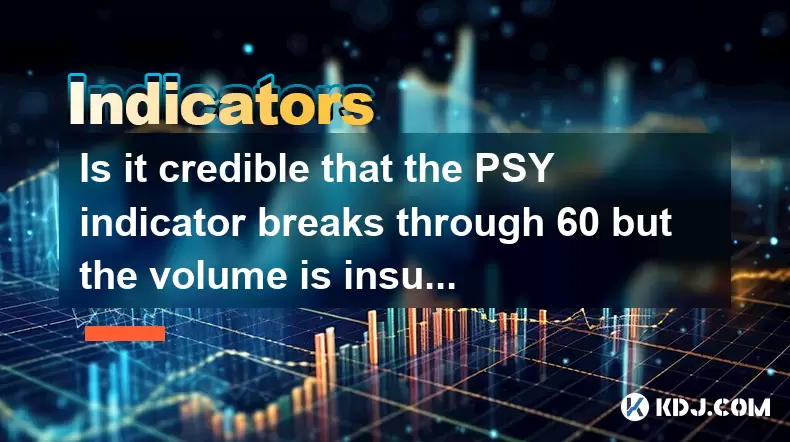
Is it credible that the PSY indicator breaks through 60 but the volume is insufficient?
Jun 14,2025 at 12:14am
Understanding the PSY Indicator in Cryptocurrency TradingThe Psychological Line (PSY) indicator is a momentum oscillator used primarily to measure the sentiment of traders and investors in financial markets, including the cryptocurrency space. It calculates the ratio of days where prices closed higher versus lower over a specified period, typically 12 o...
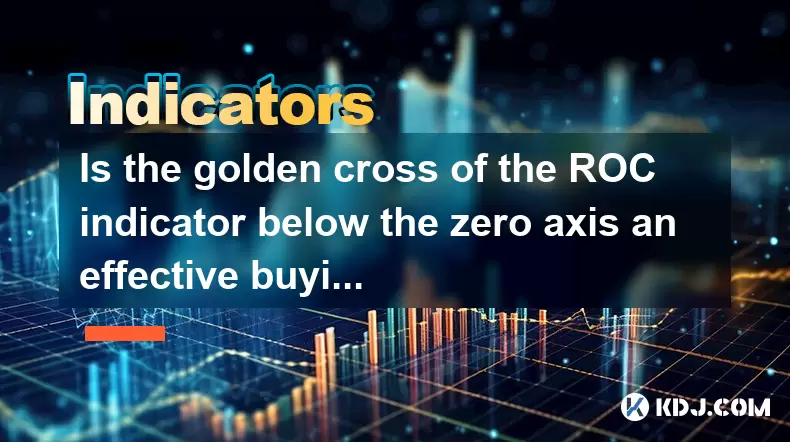
Is the golden cross of the ROC indicator below the zero axis an effective buying point?
Jun 14,2025 at 01:29am
Understanding the ROC Indicator and Its SignificanceThe Rate of Change (ROC) indicator is a momentum oscillator used in technical analysis to measure the percentage change in price between the current closing price and the closing price from a set number of periods ago. This tool helps traders assess the speed at which prices are changing, offering insi...

Will the RSI fall after the top divergence? How to improve the judgment accuracy?
Jun 13,2025 at 11:21pm
Understanding RSI and Top Divergence in Cryptocurrency TradingThe Relative Strength Index (RSI) is a momentum oscillator widely used in cryptocurrency trading to measure the speed and change of price movements. It typically ranges from 0 to 100, with levels above 70 considered overbought and below 30 considered oversold. In crypto markets, where volatil...
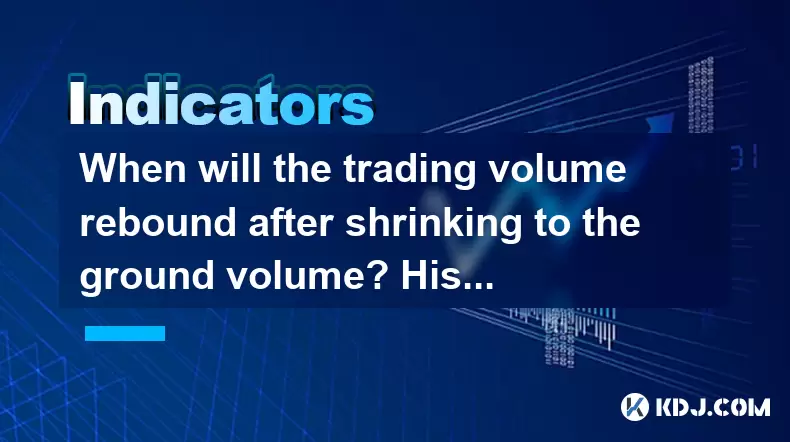
When will the trading volume rebound after shrinking to the ground volume? Historical percentile comparison method
Jun 13,2025 at 03:36pm
Understanding the Ground Volume Concept in Cryptocurrency MarketsIn cryptocurrency trading, 'ground volume' refers to a period when the trading volume of a particular asset or market drops significantly, often reaching multi-month or even multi-year lows. This phenomenon typically signals a lack of interest from traders and investors, suggesting that th...
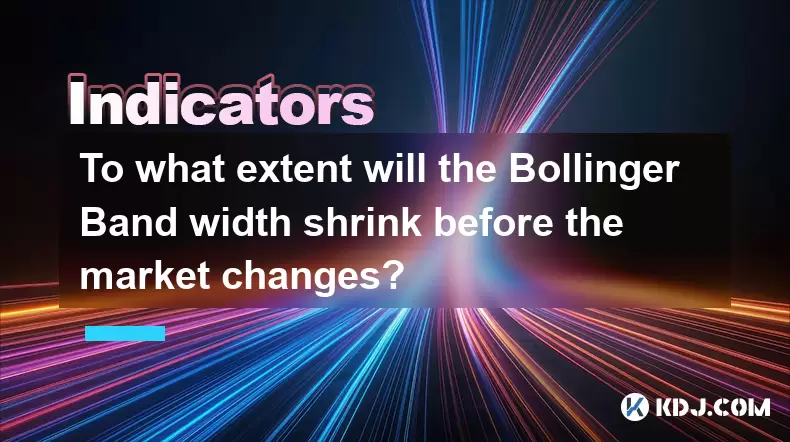
To what extent will the Bollinger Band width shrink before the market changes?
Jun 13,2025 at 06:35pm
Understanding the Bollinger Band Width and Its SignificanceThe Bollinger Band width is a critical technical analysis tool used in cryptocurrency trading to measure market volatility. It consists of three lines: a simple moving average (SMA), an upper band, and a lower band. The distance between the upper and lower bands reflects the level of volatility ...
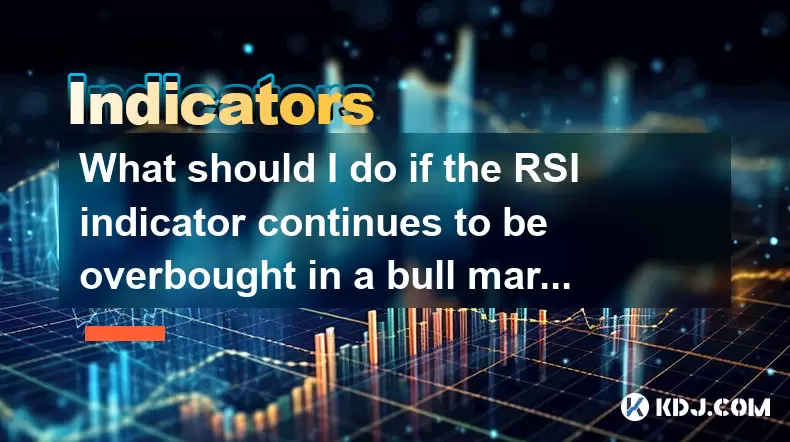
What should I do if the RSI indicator continues to be overbought in a bull market? How to adjust the overbought zone threshold?
Jun 13,2025 at 05:57pm
Understanding the RSI Indicator in a Bull MarketThe Relative Strength Index (RSI) is a momentum oscillator commonly used by traders to assess overbought or oversold conditions of an asset. In a bull market, especially within the cryptocurrency space, prices can remain elevated for extended periods. This often leads to the RSI indicator staying in the ov...

Is it credible that the PSY indicator breaks through 60 but the volume is insufficient?
Jun 14,2025 at 12:14am
Understanding the PSY Indicator in Cryptocurrency TradingThe Psychological Line (PSY) indicator is a momentum oscillator used primarily to measure the sentiment of traders and investors in financial markets, including the cryptocurrency space. It calculates the ratio of days where prices closed higher versus lower over a specified period, typically 12 o...

Is the golden cross of the ROC indicator below the zero axis an effective buying point?
Jun 14,2025 at 01:29am
Understanding the ROC Indicator and Its SignificanceThe Rate of Change (ROC) indicator is a momentum oscillator used in technical analysis to measure the percentage change in price between the current closing price and the closing price from a set number of periods ago. This tool helps traders assess the speed at which prices are changing, offering insi...

Will the RSI fall after the top divergence? How to improve the judgment accuracy?
Jun 13,2025 at 11:21pm
Understanding RSI and Top Divergence in Cryptocurrency TradingThe Relative Strength Index (RSI) is a momentum oscillator widely used in cryptocurrency trading to measure the speed and change of price movements. It typically ranges from 0 to 100, with levels above 70 considered overbought and below 30 considered oversold. In crypto markets, where volatil...

When will the trading volume rebound after shrinking to the ground volume? Historical percentile comparison method
Jun 13,2025 at 03:36pm
Understanding the Ground Volume Concept in Cryptocurrency MarketsIn cryptocurrency trading, 'ground volume' refers to a period when the trading volume of a particular asset or market drops significantly, often reaching multi-month or even multi-year lows. This phenomenon typically signals a lack of interest from traders and investors, suggesting that th...

To what extent will the Bollinger Band width shrink before the market changes?
Jun 13,2025 at 06:35pm
Understanding the Bollinger Band Width and Its SignificanceThe Bollinger Band width is a critical technical analysis tool used in cryptocurrency trading to measure market volatility. It consists of three lines: a simple moving average (SMA), an upper band, and a lower band. The distance between the upper and lower bands reflects the level of volatility ...

What should I do if the RSI indicator continues to be overbought in a bull market? How to adjust the overbought zone threshold?
Jun 13,2025 at 05:57pm
Understanding the RSI Indicator in a Bull MarketThe Relative Strength Index (RSI) is a momentum oscillator commonly used by traders to assess overbought or oversold conditions of an asset. In a bull market, especially within the cryptocurrency space, prices can remain elevated for extended periods. This often leads to the RSI indicator staying in the ov...
See all articles
























